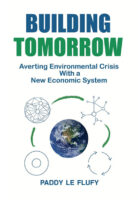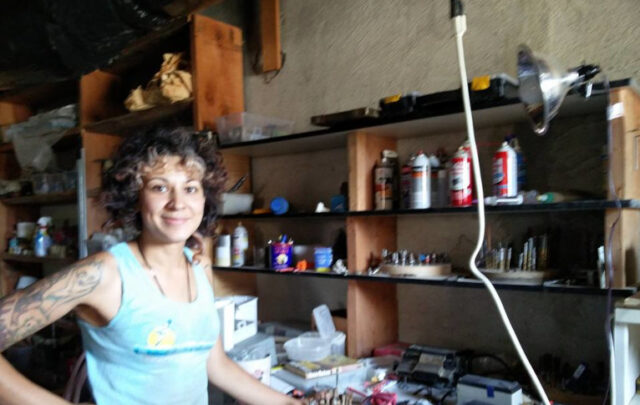 Building Tomorrow: Averting Environmental Crisis With a New Economic System
Building Tomorrow: Averting Environmental Crisis With a New Economic System
By Paddy Le Flufy
First Light Books, Mar. 2023, 242 pp., ebook: $8.99, paperback: $18.99.
For years Paddy Le Flufy led what he calls a “double life.” He spent six months of the year as a finance specialist in London and the other six visiting parts of the world where people lived in stark contrast to his London lifestyle. He had the experience of living with and learning from economic migrants, rural Mozambicans and Hadza hunter-gatherers. This extraordinary background gives him, among other things, a fascinating perspective on the environmental and economic challenges facing the modern developed world.
He brings this perspective fully to bear in his book Building Tomorrow, which examines six organizational technologies—defined by Le Flufy as “the processes and institutions we use to organise society”—with the potential to bring about a new economic system capable of satisfying humanity’s needs within planetary limits. The book gives real-world examples and practical guidance on how individuals and organizations can implement these technologies right now, without having to wait for legal reforms or approval from within the current system.
Le Flufy writes early on, “I have extensively studied the technologies I write about, so I can describe them clearly and in detail.” This statement is amply borne out by the book’s subsequent chapters, with their sheer breadth of information, depth of coverage and trove of firsthand insight. And as thorough as the book is, it’s equally readable: It is well-written, uses minimal jargon, and makes excellent use of examples and visual illustrations to convey key concepts. At less than 200 pages—not counting appendices and other back matter—it is also a model of concision.
Le Flufy starts with an urgent warning about one of the most critical consequences of our current economic system: the climate crisis. He summarizes the latest alarming projections by the Intergovernmental Panel on Climate Change and the escalating impacts of climate change in the present day, and laments the woeful inadequacy of efforts like renewable energy investments and carbon taxes to address the crisis. For those weary of hearing about problems and eager to explore solutions, it should come as a relief that this part of the book takes up only three pages.
The first organizational technology examined by Le Flufy is the Doughnut development paradigm, which uses a visual aid called the Doughnut to gauge whether an economy is meeting the needs of its people without exceeding Earth’s limits. (Ed. note: Doughnut Economics was developed by Kate Raworth in her book of the same name.) The diagram consists of an outer ring representing ecological limits, a hole at the center representing people who lack life essentials, and a band in between signifying “the safe and just space for humanity.”
The book looks at various efforts to apply the Doughnut at every scale, from the global to the local. One of the more poignant revelations to come of this analysis is that the world doesn’t currently have any developed countries, insofar as the Doughnut paradigm defines a developed country—namely, one in which social needs are balanced with planetary boundaries. Equally poignant is that there’s no one-size-fits-all path to development, since each country or region has its own unique needs, challenges and socio-environmental context that must be navigated on its way to becoming developed. Thus there’s endless room for innovation and creativity as different communities create their own unique development strategies to suit their particular situations.
The second organizational technology, the circular economy, seeks to eliminate waste by mirroring nature’s continuous renewal of water, nutrients and other resources. In our current economy, products and materials are typically thrown away after use in an unsustainable, linear pattern of consumption. A circular economy keeps products and materials in circulation for as long as possible by ensuring that they’re reused, recycled or otherwise repurposed rather than being thrown into landfills. The potential for energy conservation, reduced resource extraction and long-term environmental sustainability in such an economy is truly staggering.
Le Flufy highlights a number of companies that are currently practicing a range of circular strategies, from adopting a “sale-of-service” model in which customers pay for the use of products rather than owning them, to creating modular products that allow for easy replacement of parts, to making products from natural, compostable materials like mycelium.
He then turns to the concept of the “Future Guardian,” a new type of business entity that balances the traditional profit motive with stakeholder interests and the broader societal good. A company that follows this model has an overall purpose and six subordinate aims, one for each of six stakeholder groups: customers, employees, investors, commercial partners, the community and the environment. Investors in Future Guardian companies do not have voting rights; instead, they have custodian representatives who represent their interests. These custodian representatives, along with stewards, play a role in mediating between the custodians and the operating board.
The book gives three examples of Future Guardians: the hydrogen fuel cell car company Riversimple, the outdoor clothing manufacturer Patagonia and the ethical smartphone manufacturer Fairphone. Riversimple is revolutionizing the traditional business model of car makers by replacing it with a sale-of-service model. This benefits customers by relieving them of the financial burden of vehicle ownership, and it helps the environment by promoting the use of eco-friendly transportation. Patagonia and Fairphone are both stellar examples of the “B Corp,” a type of corporation that balances profits with social and environmental impacts by meeting rigorous social and environmental standards.
The final three organizational technologies are focused on improving how money and economic systems work for the mutual benefit of people and the planet. Le Flufy covers them just as thoroughly and accessibly as he does the others.
The book’s content is cumulative, with each chapter exploring how its particular technology can be used in conjunction with those presented in previous chapters, and the conclusion showing how all six might “combine to open up previously unimagined possibilities for development,” in Le Flufy’s words. For example, Le Flufy proposes the establishment of a community-owned circular clothing factory, with funding sourced from local Future Guardian businesses. People would pay for their clothing using a dedicated currency, potentially called Threads, exclusively designed for this purpose, and would return their old clothing to be recycled. This model would effectively provide the entire town with an ongoing supply of free clothing. Le Flufy gives plenty of other similarly brilliant, inspiring examples.
The two appendices, consisting of Riversimple’s articles of association and a comprehensive explanation of indicators and boundaries of the Doughnut, are invaluable resources for anyone looking to establish a Doughnut economy or a company based around a circular economy model.
For those seeking clear, practical guidance on what they can do to help steer our society away from its current unsustainable, perpetual-growth economy toward a sustainable, harmonious one, Building Tomorrow is highly recommended.






